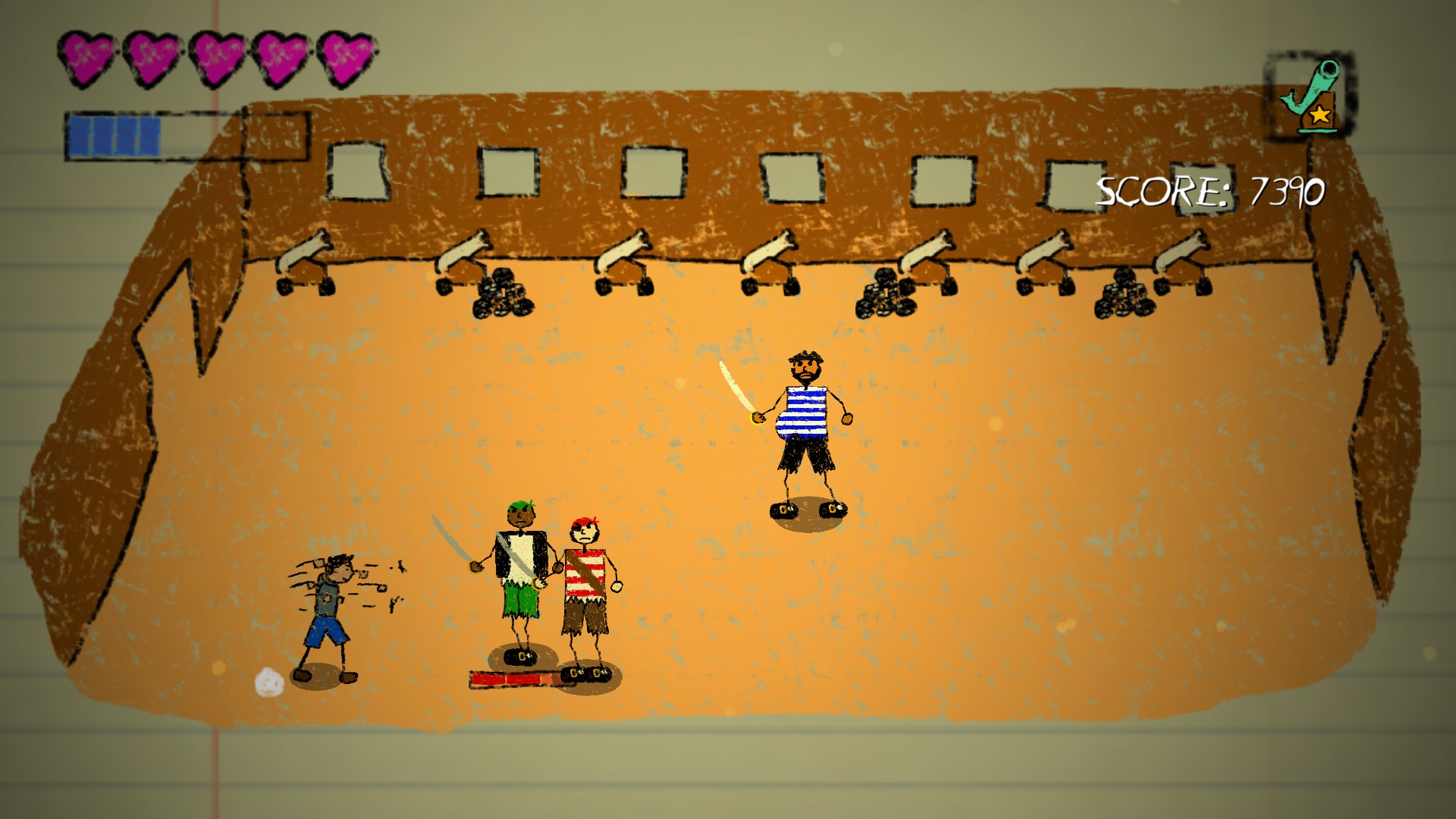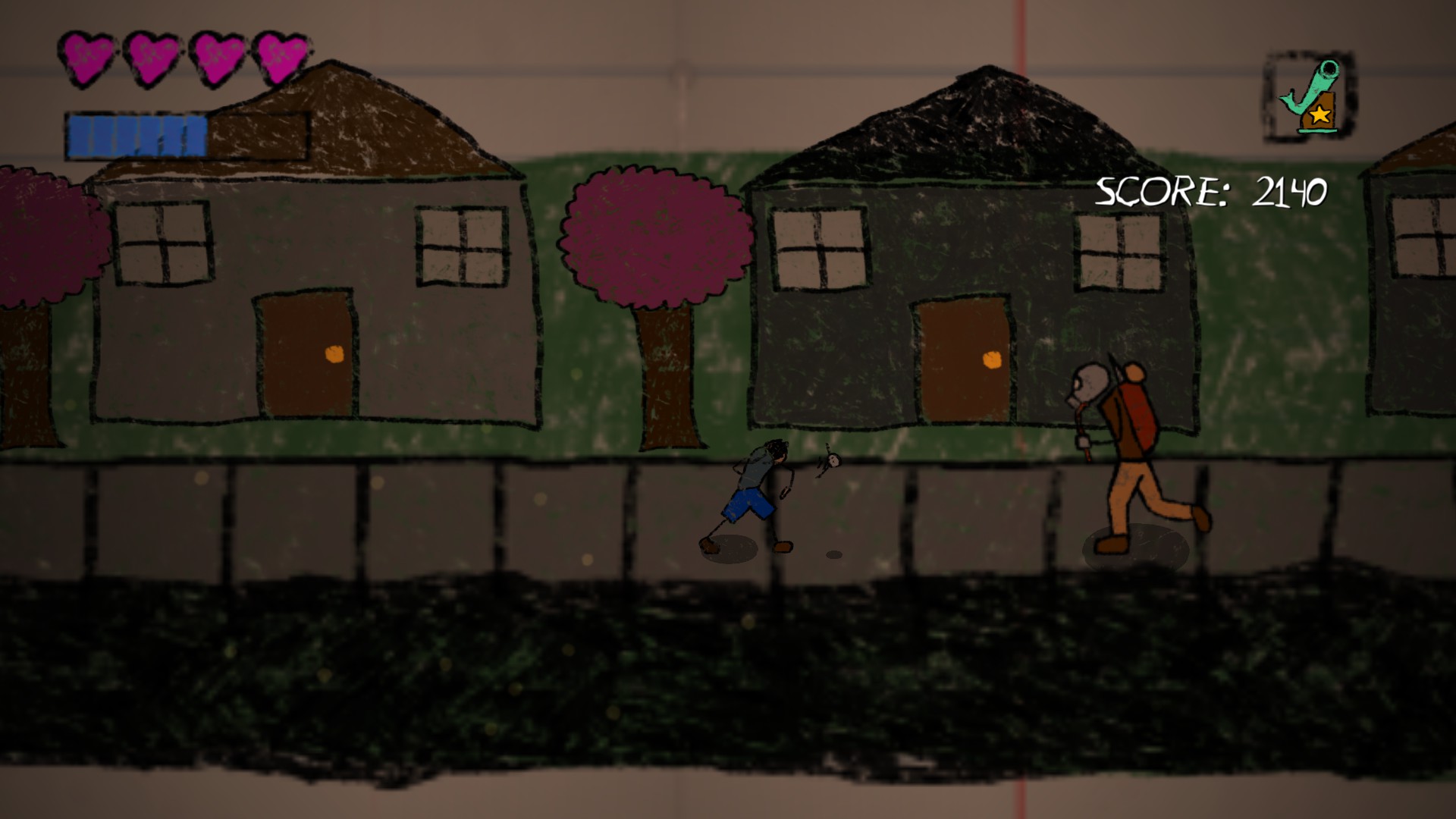Search
[{{{type}}}] {{{reason}}}
{{/data.error.root_cause}}{{{_source.title}}} {{#_source.showPrice}} {{{_source.displayPrice}}} {{/_source.showPrice}}
{{#_source.showLink}} {{/_source.showLink}} {{#_source.showDate}}{{{_source.displayDate}}}
{{/_source.showDate}}{{{_source.description}}}
{{#_source.additionalInfo}}{{#_source.additionalFields}} {{#title}} {{{label}}}: {{{title}}} {{/title}} {{/_source.additionalFields}}
{{/_source.additionalInfo}}Hero Boy (PC)

Hero Boy
Developed By: Crowned Daemon Studios
Published By: Crowned Daemon Studios
Released: October 31, 2016
Available On: Linux, MacOS, Windows
Genre: 2D beat ‘em up
ESRB Rating: N/A
Number of Players: 1
Price: $4.99
Thanks to Crowned Daemon Studios for the review key!
Every horror story, it seems, needs its child character. For the most part, you get your Clementines or your Ellies: children mature beyond their years and with a strength of body and mind that borders on abnormal. What about the more normal children, the introverted kids who struggle with bullies? If Hero Boy is any indication, they can certainly carry a story as well.
Hero Boy tells the story of Max, an eight year old with a penchant for drawing and daydreaming. He lives a rather normal eight-year-old life – getting mugged by bullies and scolded by teachers included – until the zombies stagger into town. His mother takes him on the road, where he balances a reality of horrors and danger with an imagination full of whimsy and heroism – and, as it turns out, horrors of its own.
The obvious standout, and the game’s greatest strength, is in its art style: the game is presented as a story written and illustrated by Max, and his crayon drawings comprise the majority of the graphics. Each stage, be it a beach, a forest, or a circus tent, is comprised of colorful scribbles that are both charming and easily identifiable, usually on a background of lined paper. It also lends some great dissonance when Max’s nightmares start – like the tried and true “little girl creepily singing a nursery rhyme” trope, childish creativity and unknown horrors blend together to create an eerie, disturbing atmosphere.

Strong Points: Inventive art style that adds to the game’s atmosphere; consistent game mechanics
Weak Points: Low variety in enemy attacks; repetitive stages; technical issues, some game-breaking
Moral Warnings: Blood; undead enemies; disturbing imagery; “hell” crops up a few times
The gameplay within the world, however, is somewhat middling. To its credit, Hero Boy adds to the basic beat ‘em up genre by giving Max light, medium, and heavy attacks, each with a two- or three-hit combo with varying levels of damage, hitstun, and knockback. He also has a shoulder charge that sends enemies flying, and can throw rocks from afar for weak damage. As the game progresses, he gains a total of five special weapons, their usage dictated by an energy bar that fills by either defeating enemies or collecting cans of pop. While the heavy combo’s high damage, range, and knockback will be your go-to attack for the majority of the game, the others do have their uses. The same can’t be said of the special moves, as the drill – which lasts a while, lets you move around, and renders Max invincible – and the magic mace – which does low damage but refills Max’s health – are vastly superior to the exploding punch, mermaid cannon, and laser staff, which leave Max stationary and vulnerable.
Despite the relative wealth of attacking options, the soul of most beat ‘em ups lies in enemy and location variety, which Hero Boy lacks. While there are plenty of enemy variations – pirates, zombies, goblins, robots, and so on – most of the attacks are simply a melee swing or a telegraphed ranged shot. They’re dressed up nicely – for instance, the ranged robots hover, and their melee attack consists of balancing on one hand to shoot fire from its propulsion – but there are rarely any differences beyond that. The levels themselves are entirely squares and rectangles of varying size, with no obstacles beyond some crates that drop health and energy when destroyed. There’s some mismatch between the story and in-game objectives as well: a cutscene will often end with Max’s mother telling him to run away, only for you to have to defeat all enemies to move on. There are a handful of boss battles with their own mechanics involved, which is a breath of fresh air when they appear, though none are particularly difficult.
This lack of features wouldn’t be as much of a problem if the game didn’t fall into a rut of repeating itself. As written earlier, the art style and enemy variation make up for its rather shallow gameplay mechanics, but you’ll spend the vast majority of the game fighting gas-masked humans that become enraged and don’t flinch after one or two hits. They’re slow, rush at you in a straight line, and have a crowbar swing that is easily dodged by moving up or down slightly. Max has very few movement options other than a short dash that’s slower than just walking away, and his ranged option deals very little damage and keeps him firmly in place, so battles consist of baiting and punishing their one attack. With more than one on-screen, you’ll have to get them stuck on boxes or each other to have any chance at all. You’ll get real skilled at fighting them by the end of the game, at which point it becomes a chore more than anything.
The technical issues don’t help – though the most common of them help entirely too much for the most part. The aforementioned gas-masked bandits tend to just wander off for no reason and stand around doing nothing, which is baffling but appreciated when there are six of them bearing down on you. Many of the maps have a spot, usually on the sides or the far bottom, which enemies are unable to enter, letting Max safely pelt them with rocks and completely remove any challenge. This even appears in every single survival mode stage, which completely defeats the purpose of the mode to begin with – though the “forest” survival stage is unplayable anyway due to one enemy always spawning above the map where Max can’t reach, and there aren’t enough enemies around to fill his special meter. Additionally, Steam achievements exist, but don't unlock.
The most egregious problem lies in an endgame enemy that periodically transforms into any other monster in the game. If you defeat it as it’s transforming, it bugs out and remains on the map in an invisible, invincible state, and your only option is to purposefully die or, if all other enemies are gone, quit the level. Considering the game’s wonky, unreliable checkpoint system, prepare to trek through the previous gas-mask gauntlet stage two or three times for another shot at progression. Add these to a somewhat laggy and unresponsive menu – especially on a controller – and the fact that your mouse cursor remains on-screen in-game, it gives the impression that the game wasn’t too thoroughly bug-tested. To its credit, however, the actual gameplay runs very smoothly and without issue, holding its framerate even with a few dozen zombies shambling around.

Higher is better
(10/10 is perfect)
Game Score - 71%
Gameplay - 13/20
Graphics - 8/10
Sound - 6/10
Stability - 4/5
Controls - 4.5/5
Morality Score - 87%
Violence - 6.5/10
Language - 8/10
Sexual Content - 10/10
Occult/Supernatural - 9/10
Cultural/Moral/Ethical - 10/10
Hero Boy’s music is rather solid throughout – nothing that stands out, but it all fits the mood and tone of the levels and story points. The exception is, unfortunately, the song you’ll hear the most, as it plays during the gas-mask bandit encounters: a droning, repetitive track that consists mostly of the same note repeating over and over. The sound effects are generally stock and fit well enough, though they stack on top of each other and get rather loud if they play simultaneously. The buggy transforming enemies do have a death wail that contains crackly audio feedback at the end of it, however. The whole game is voice-acted, mostly by Max’s mother narrating the story, and it meshes well with the atmosphere and is of rather high quality throughout.
Hero Boy does make an attempt to have some longevity, mainly through the survival mode, but you’ll have to train yourself to avoid the safe spot to make it worthwhile. There are three difficulty options, though they don’t appear to do anything – enemies seem to take and receive the same amount of damage on easy as they do on hard. After beating the story, extra options pop up to make the game easier (defeating enemies heals Max, increased knockback) or harder (less effective or removed items, increased enemy damage). There’s also a new game plus mode that gives you all special moves from the start, though the drill tends to get Max stuck in levels before it’s formally introduced. Finally, there’s a strange “welge mode” that makes all enemies whisper “I will kill you” when defeated and gets old very quickly, and a “pandering mode” that turns the zombies into references of various real and fictional people, including BroTeamPill and Vivian James.
As a game set in a zombie apocalypse, the standard zombie-type moral issues apply, though drawn in crayon. Undead enemies are a given, with skeletons and ghouls also appearing, though these are purely in Max’s imagination. Defeated enemies in-game fly away or simply vanish, but in certain parts of the story, dead bodies with blood under and on them show up. Some of the scenes contain disturbing imagery, most notably the transforming ghouls and the bipedal elephant boss in the circus level that loses its trunk midway through the fight. Finally, though the language is mostly clear (save for the spelling; Max’s English skills are poor even for an eight-year-old), though the word “hell” does pop up in the background of the nightmare levels every so often.
Overall, Hero Boy is a charming but flawed game. The presentation is great and the gameplay is smooth, but both game design and technical issues keep it from more lofty heights. If you’re interested in the art style and the horror aspect, it’s worth a look come sale time, but if the crayon drawings don’t do it for you, you’ll find better options elsewhere.
-Cadogan








